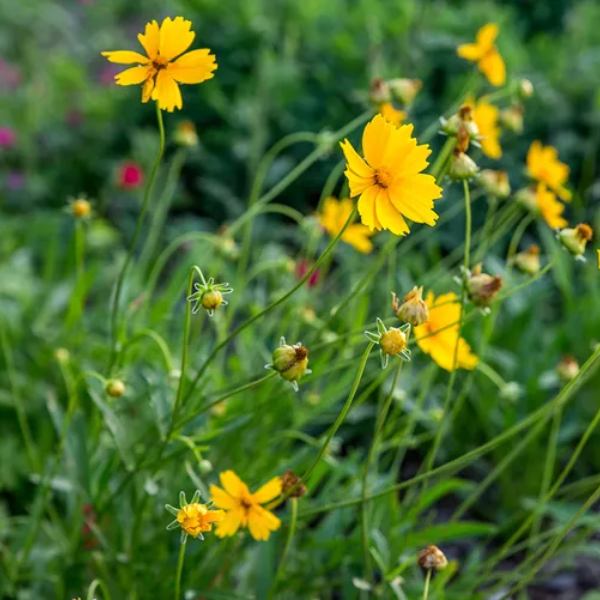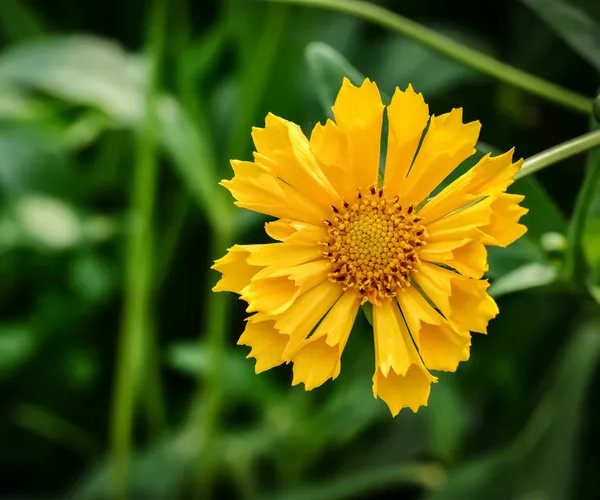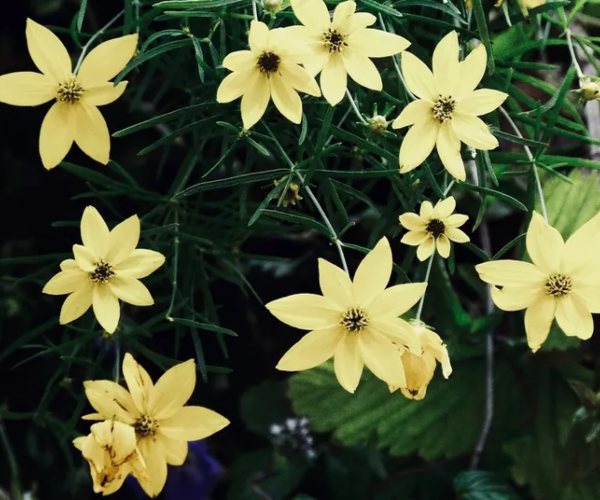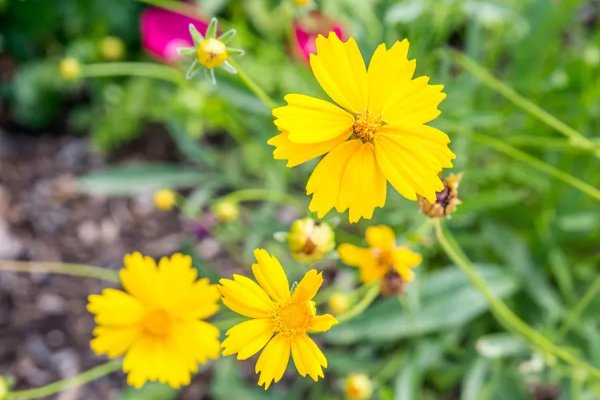If you want to have a low-maintenance, drought-tolerant, and long-blooming flower for your garden, to fill a bed, or to line a border, coreopsis plants are here. There are over 80 varieties of this plant and you can choose the best one for your garden no matter what the design is. These beautiful daisy-like flowers are not so fragrant but the foliage smells like anise. These plants are native to North America and they grow in upright clumps and flowers throughout the summer.
The species’ foliage differs as some varieties boast large green leaves and others sport a bit narrower greenery. The plant is also commonly known as tickseed which is a nod to its round seeds during fall and winter. Many pollinators like bees and butterflies are also drawn to the color blooms.
The coreopsis species have a moderate growth rate and are best when planted in spring after all risk of frost has gone. The plant’s perennial varieties grow in USDA zones 2 through 8, they die back after frost and return in the spring. In the coldest zones, you can protect the plant’s underground roots by adding a few inches of mulch. Annual varieties of coreopsis will bloom in early summer and bloom periodically through the fall. Perennial varieties will bloom the second year after planting from seed.
Plant Attributes
- Common Name: Coreopsis, tickseed, calliopsis
- Botanical Name: Coreopsis spp.
- Family: Asteraceae
- Plant Type: Perennial, biennial
- Mature Size: 2–4 ft. tall, 1-2 ft. wide
- Sun Exposure: Full
- Soil Type: Sandy, well-drained
- Soil pH: Neutral, acidic
- Bloom Time: Summer, Fall
- Flower Color: Red, orange, yellow, pink, white
- Hardiness Zones: 2-11 (USDA)
- Native Areas: North America, Central America, South America
Also, Read What Is a Perennial? How to Choose and Care for Perennial Plants!
Coreopsis Care
The good news is that Coreopsis plants do not require much care when grown in their preferred environment. Choose a planting site that has good sunlight and good soil drainage. Do not forget to leave some space around each plant for air circulation. Some varieties of the tickseed may need support as they mature; otherwise, the stems might bow down. Also, removing the spent blooms can help the plant bloom throughout summer into fall.

Light
Coreopsis plants thrive in full sun which means they require at least six to eight hours of direct light most of the days. They can also do in partial sun but the results might be that the plants might be a bit lankier and now flower as they should. However, during very hot summers, some afternoon shade is okay.
Soil
These plants love well-draining, loamy, and sandy soil with a neutral soil pH. Having said that, most of the coreopsis varieties are straightforward to grow and aren’t that fussy about soil quality or soil pH as long as you don’t waterlog them. You might have noticed that some of the most extreme blooming happens on the untamed border of roadways or other neglected areas. If you want the bloom to be profuse, heavy and wet clay soils should be amended with compost to support drainage.
Water
If you’ve just planted new coreopsis plants, you need to regularly water them to keep them moist but not soggy until they are matured. After their first year, these plants become drought tolerant, but they will bloom most amazingly with regular watering. It is best to do so early morning as it allows a chance to dry out during the day.
Temperature and Humidity
Coreopsis plants prefer warm temperatures between 70 and 80 degrees Fahrenheit during the day and 50 and 60 degrees Fahrenheit during nighttime. As long as the air circulation is good and there is proper watering and drainage, high humidity levels aren’t a problem. Having said that, various species of coreopsis have different levels of cold tolerance.
Fertilizer
Fertilizer is only necessary for coreopsis plants if the soil is very poor. Fertilizing often can promote excessive foliage growth at the expense of the plant flower. To ensure your plant’s growth, you can add a little compost into the soil at the start of spring.

Types of Coreopsis
There are lots of species and varieties of coreopsis and most of them differ in appearance than care. Some of the most popular varietals for outdoor cultivation are:
- Coreopsis grandiflora ‘Early Sunrise‘: This variety has large, semi-double, bright yellow flowers that start blooming in early summer.
- Coreopsis grandiflora ‘Golden Showers’: This variety has profuse yellow blooms on longer-than-average stems.
- Coreopsis verticillata ‘Moonbeam’: This variety has buttery yellow flowers with a compact and dense shape.
- Coreopsis rosea Nana: This is a mauve-pink dwarf variety that spreads nicely but isn’t drought tolerant.
Pruning
Pruning is helpful for coreopsis. Cutting back the top of a declining perennial to the ground or near ground level promotes extreme new growth. It will also enhance and refresh the plant. To get continuous blooms, you can cut back during the growing season. Removing dead blooms and stems can help encourage plant blooms throughout summer and fall. Remember that the plant will not grow flower buds on a stem that once held a faded flower.
How to propagate coreopsis
There is no doubt that perennial coreopsis are resilient plants but their lifespan is not more than three to five years. If you see decreasing flowering, it is the time you divide the plants to propagate them. Spring or early fall is the best time to divide your plant and here is how:
- First things first, carefully dig up a clump of a mature plant, leaving the roots intact.
- Using a sharp trowel, split the clump into smaller sections, ensuring several healthy roots are present in each section.
- Replant the sections in a proper growing site. Water the new plants well until they’re established and show visible signs of growth, which might take several weeks.

How to Grow Coreopsis From Seed
Many coreopsis varieties can be grown from seeds. Often, they will reseed themselves in your garden. Start seed indoors six to eight weeks before your area’s last frost date. You can also directly plant seeds in your garden after your last frost.
It is essential to plant the seeds almost 1/2 inch deep and then keep the soil slightly moist and warm. You will start noticing seedlings in about two to three weeks, at which point you can keep them near a sunny window and keep their soil evenly moist.
Indoor seedlings should be accustomed to the outer climate slowly by taking them out for some hours each day for about a week. Then, they are fully ready to be planted in your garden and make it look beautiful.
Potting and Repotting Coreopsis
Coreopsis can be grown in pots. If you start them in a seedling container, you can later size them up and move them into larger ones. Coreopsis requires containers that are at least 8 to 10 inches deep and wide with multiple drainage holes so that standing water is not a problem. As mentioned above, the roots of this plant do not tolerate soggy and standing water.
After years of planting, if the plant’s roots grow out of the drainage holes, it is the right time to divide the plant. Once that is done, replant the division in its container and backfill the rest with fresh soil.
Keep the container in a location where it gets at least six to eight hours of full sun. In the hot summers, water is more if it’s planted in the container because the containers heat up and water evaporates from potting soil much quicker than in-ground plants.
Common Pests and Plant Diseases
Mostly, coreopsis grows without any problems. But some insects like snails, slugs, and fungal diseases in wet seasons might prey on them. Before choosing insecticides and pesticides, try improving your plant’s environment. Make sure that the plant has enough air circulation to deter pests and fungal problems. Also, check if it is getting enough sunlight. Divide overgrown clumps where the centers of the plant are not getting enough air or light.
FAQs
Q: Are coreopsis low-maintenance plants?
A: Yes, coreopsis plants do not need much attention and thrive even when neglected a bit.
Q: How long can coreopsis live?
A: Coreopsis plants can remain in good state for up to five years. At that point, while the plant may not die off, it will slowly deteriorate, producing fewer blooms and new growth. Replace your coreopsis plants with new plantings every few years.
Q: How fast does coreopsis grow?
A: Coreopsis plants grow moderately fast and will establish themselves in your garden within a few months. But, when started from seed, coreopsis will not flower until their second year.
Q: Are coreopsis perennials?
A: Some coreopsis are annuals, living only one year, and some are perennials, returning yearly. If you want coreopsis to grow back, it will depend on your USDA zone and the type of coreopsis that you get.
Also, Read Green Guardians: These 12 Plants Can Improve Your Soil Quality
